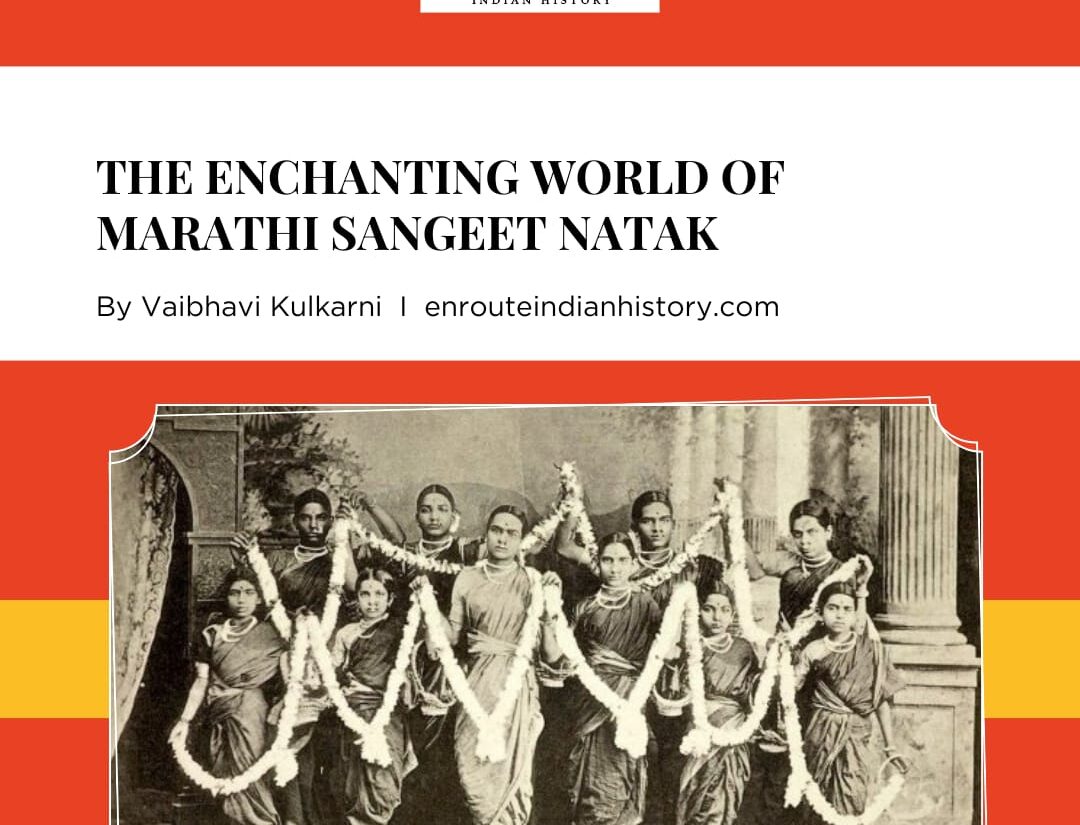
Imagine a dimly lit auditorium, the air thick with anticipation. The curtain rises to reveal actors in resplendent traditional attire, their voices soaring melodiously as the story unfolds through a seamless blend of dialogue and song.
This is the captivating world of Marathi Sangeet Natak, a unique theatrical genre from Maharashtra that has mesmerized audiences for over two centuries.
Marathi Sangeet Natak, with its enchanting blend of theatrical drama and symphonic music, is a unique gift to the world. A harmonious amalgamation of drama and music, has given birth to the distinctive musical genre known as Natyasangeet. From its origins in the 19th century to its modern-day revival, this art form has continuously evolved, incorporating diverse musical genres and reflecting the rich cultural heritage of Maharashtra. Natyasangeet, the musical heart of Marathi Sangeet Natak, stands as a testament to the creativity and innovation of Marathi artists, offering a harmonious symphony of classical, devotional, and popular music.

Marathi Theatrical Group, Mumbai 1870 (Source: Google)
The Birth of Marathi Sangeet Natak
Marathi Sangeet Natak traces its origins to the 19th century, a period marked by social and cultural transformation in India. The seeds of this art form were sown in traditional folk theatre and early modern drama, which were prevalent across rural and urban Maharashtra. It was during this time that visionary artists like Vishnudas Bhave and Annasaheb Kirloskar emerged, laying the foundation for what would become a flourishing theatrical tradition.
Vishnudas Bhave, often hailed as the father of Marathi theatre, began incorporating musical elements into his plays, recognizing the power of music to enhance the emotional and narrative impact of drama. His pioneering efforts paved the way for others, including Annasaheb Kirloskar, whose adaptations of classical Sanskrit plays into Marathi musical theatre were instrumental in defining the genre. Kirloskar’s work, particularly his adaptation of Kalidasa’s ‘Shakuntala,’ set a high standard for the integration of music and drama, establishing a legacy that would influence generations of playwrights and composers. This innovation was both a reflection of and a response to the cultural milieu of the time, blending traditional narratives with modern sensibilities.
Following Kirloskar, several playwrights and composers contributed to the evolution of Sangeet Natak. Balwant Pandurang Kirloskar (alias Annasaheb Kirloskar), Krishnaji Prabhakar Khadilkar, and Govind Ballal Deval were instrumental in popularizing this art form. Their works, such as Khadilkar’s ‘Sangeet Manapman’ and Deval’s ‘Sangeet Sharada,’ are still celebrated for their rich musical compositions and engaging storytelling. ‘Sangeet Sharada’ is credited as being the first play in Marathi to address social issues and break conventions by tackling the topic of child marriage at a time when historical-mythological narratives dominated theatrical literature in India.

Sangeet Manapman (Source: Google)
The Emergence of Natyasangeet
Natyasangeet, a genre that emerged from the fertile ground of Marathi Sangeet Natak, is characterized by its unique blend of music and drama. Unlike other musical forms, Natyasangeet is not merely an accompaniment to the action on stage but an integral part of the storytelling itself. Natyasangeet has carved out a unique identity through its distinctive vocal styles, lyrical content, and orchestration. The vocal delivery in Natyasangeet is characterized by its clarity, emotional expressiveness, and adherence to classical techniques. The lyrics, often poetic and evocative, delve into complex human emotions and philosophical themes, providing a deep and reflective narrative layer to the plays. The songs in a Marathi Sangeet Natak are crafted to convey emotions, advance the plot, and provide deeper insights into the characters’ inner worlds.
The evolution of Natyasangeet was marked by a gradual incorporation of diverse musical elements. Initially, the songs were heavily influenced by classical Indian music, particularly Hindustani classical music. Over time, elements of Bhav Sangeet (emotive devotional songs) and Sugam Sangeet (light, popular music) were woven into the fabric of Natyasangeet, creating a rich tapestry of sounds and styles. This fusion of genres not only broadened the appeal of Natyasangeet but also showcased the versatility and creativity of Marathi composers and performers. Natyasangeet songs are known for their classical base, intricate rhythms, and emotive lyrics that enhance the dramatic effect of the performances.
For instance, Annasaheb Kirloskar’s ‘Sangeet Saubhadra’ is renowned for its beautiful compositions such as ‘Radhadhar Madhu Milind,’ ‘Nabha Meghani Aakramile’ which depicts the intense emotions and is celebrated for its lyrical and melodic richness. In Krishnaji Prabhakar Khadilkar’s ‘Sangeet Swayamvar,’ the song ‘Narvar Krishnasamaan’ showcases the fusion of classical music with dramatic storytelling, becoming a staple in Marathi musical theater. In ‘Sangeet Sharada’ by Govind Ballal Deval, the song ‘Balapanicha Kaal Sukhacha’ stands out as a poignant piece that conveys deep emotional resonance, illustrating the character’s inner turmoil and longing for childhood. Krishnaji Prabhakar Khadilkar’s ‘Sangeet Manapman’ features the iconic nandi ‘Naman Natavara Vismaykara,’’ a devotional invocation that sets the tone for the play and remains a popular rendition to this day. Another notable example is the play ‘Katyar Kaljat Ghusli’ by Purushottam Darvhekar, which features memorable songs like ‘Ghei Chhand Makarand,’ ‘Ya bhavanatil geet purane,’ ‘Surat PiyaKi Na Chin Bisaraye,’ showcases the variety of song types such as kavvali, thumri, classical music, bhajan, etc
These compositions not only serve the narrative but also stand alone as significant pieces of music, contributing to the rich heritage of Maharashtra. The fusion of music and drama in Marathi Sangeet Natak thus represents a sophisticated art form where the music is not just an accompaniment but a vital component of the storytelling process. Natyasangeet’s ability to blend theatrical performance with musical excellence has established it as a unique genre that transcends conventional boundaries. It is a testament to the creativity and innovation of Marathi artists, who have continuously evolved and adapted the form to keep it relevant and resonant with contemporary audiences.

Poster of play, ‘Sangeet Sharada’ (Source: Google)
Eminent Personalities of Marathi Sangeet Natak
The world of Marathi Sangeet Natak has been graced by numerous luminaries whose contributions have left an indelible mark on the art form. Annasaheb Kirloskar, often regarded as the father of Marathi musical theater, set the foundation with his visionary works. Krishnaji Prabhakar Khadilkar and Govind Ballal Deval expanded the repertoire with their innovative plays and memorable compositions. In the 20th century, artists like Bal Gandharva (Narayan Shripad Rajhans) became synonymous with Sangeet Natak. His portrayal of female characters and his exceptional singing talent brought a new dimension to the genre. Similarly, Master Dinanath Mangeshkar, also made significant contributions, both as a performer and a mentor to future generations of artists. Along with them, Pandit Ram Marathe, Saudagar, Nagnath Gore (Chhota Gandharva), Bhalchandra Pendharkar, Vasantrao Deshpande, Jitendra Abhisheki, Jaymala Shiledar, Jyotsna Bhole, and Manik Varma are also notable figures of Marathi Sangeet Natak. These eminent personalities have not only preserved the legacy of Marathi Sangeet Natak but have also enriched it, ensuring that this unique blend of drama and music continues to captivate audiences. Their contributions have made Natyasangeet a cherished tradition in Indian theater, celebrating the rich cultural heritage of Maharashtra.

A scene from Sangeet Saubhadra (Source: Google)
Modern-Day Relevance and Revival
Despite the passage of time, Marathi Sangeet Natak and Natyasangeet remain relevant and influential in contemporary culture. Modern-day performances often incorporate innovative staging techniques, contemporary themes, and new musical compositions, keeping the genre fresh and engaging for today’s audiences. Contemporary artists and organizations dedicated to reviving and promoting Marathi Sangeet Natak play a crucial role in its continued vitality. They organize workshops, performances, and festivals, creating platforms for both seasoned performers and emerging talents to showcase their skills and contribute to the genre’s evolution.

A scene from play, ‘Sangeet Devababhali’ (Source: Google)
As we celebrate the enchanting world of Marathi Sangeet Natak, we recognize its enduring appeal and cultural significance, highlighting its role in preserving and promoting Maharashtra’s intangible heritage. This unique art form, with its profound emotional and artistic impact, continues to captivate audiences, ensuring its place in the cultural tapestry of India and the world.
Bibliography:
https://vishesh.maayboli.com/diwali-2009/664
https://www.indiatoday.in/india-today-insight/story/maharashtra-to-document-sangeet-natak-tradition-for-posterity-2493122-2024-01-24
https://www.amarchitrakatha.com/literature_details/the-pioneers-of-marathi-natyasangeet/
- Annasaheb Kirloskar
- Bal Gandharva
- Evolution of Natyasangeet
- Famous Marathi Sangeet Natak performances
- Govind Ballal Deval
- Impact of Sangeet Natak on Marathi culture
- Krishnaji Prabhakar Khadilkar
- Marathi Sangeet Natak composers
- Marathi Sangeet Natak history
- Marathi theatre musical traditions
- Master Dinanath Mangeshkar
- Natyasangeet evolution
- Natyasangeet in Marathi theatre
- Popular Marathi musical dramas
- Traditional Marathi musical theatre
- Vishnudas Bhave

















